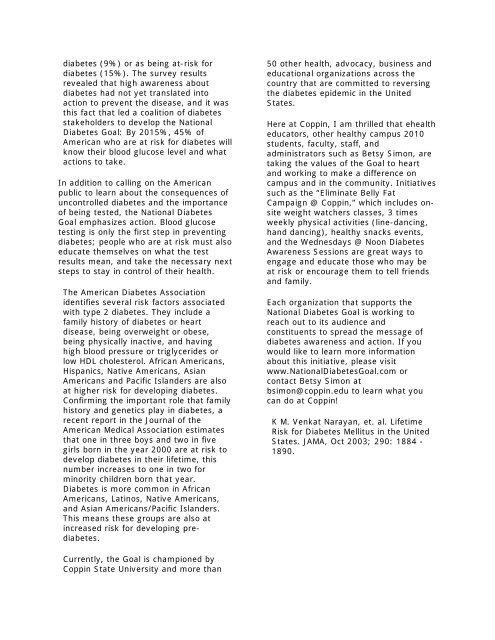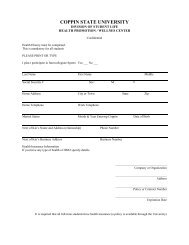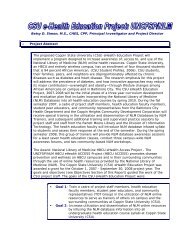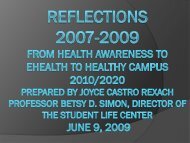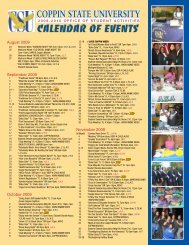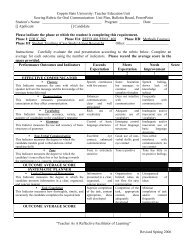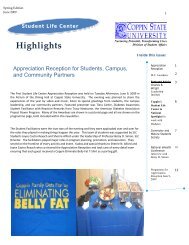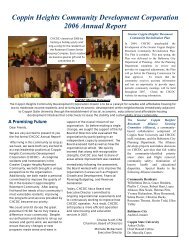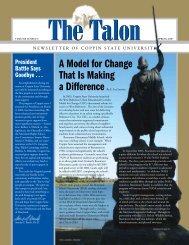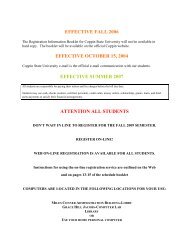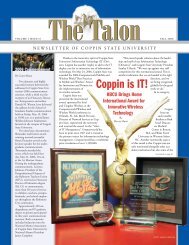Betsy D. Simon, Coordinator The National Diabetes Goal: Turning ...
Betsy D. Simon, Coordinator The National Diabetes Goal: Turning ...
Betsy D. Simon, Coordinator The National Diabetes Goal: Turning ...
You also want an ePaper? Increase the reach of your titles
YUMPU automatically turns print PDFs into web optimized ePapers that Google loves.
diabetes (9%) or as being at-risk for<br />
diabetes (15%). <strong>The</strong> survey results<br />
revealed that high awareness about<br />
diabetes had not yet translated into<br />
action to prevent the disease, and it was<br />
this fact that led a coalition of diabetes<br />
stakeholders to develop the <strong>National</strong><br />
<strong>Diabetes</strong> <strong>Goal</strong>: By 2015%, 45% of<br />
American who are at risk for diabetes will<br />
know their blood glucose level and what<br />
actions to take.<br />
In addition to calling on the American<br />
public to learn about the consequences of<br />
uncontrolled diabetes and the importance<br />
of being tested, the <strong>National</strong> <strong>Diabetes</strong><br />
<strong>Goal</strong> emphasizes action. Blood glucose<br />
testing is only the first step in preventing<br />
diabetes; people who are at risk must also<br />
educate themselves on what the test<br />
results mean, and take the necessary next<br />
steps to stay in control of their health.<br />
<strong>The</strong> American <strong>Diabetes</strong> Association<br />
identifies several risk factors associated<br />
with type 2 diabetes. <strong>The</strong>y include a<br />
family history of diabetes or heart<br />
disease, being overweight or obese,<br />
being physically inactive, and having<br />
high blood pressure or triglycerides or<br />
low HDL cholesterol. African Americans,<br />
Hispanics, Native Americans, Asian<br />
Americans and Pacific Islanders are also<br />
at higher risk for developing diabetes.<br />
Confirming the important role that family<br />
history and genetics play in diabetes, a<br />
recent report in the Journal of the<br />
American Medical Association estimates<br />
that one in three boys and two in five<br />
girls born in the year 2000 are at risk to<br />
develop diabetes in their lifetime, this<br />
number increases to one in two for<br />
minority children born that year.<br />
<strong>Diabetes</strong> is more common in African<br />
Americans, Latinos, Native Americans,<br />
and Asian Americans/Pacific Islanders.<br />
This means these groups are also at<br />
increased risk for developing prediabetes.<br />
50 other health, advocacy, business and<br />
educational organizations across the<br />
country that are committed to reversing<br />
the diabetes epidemic in the United<br />
States.<br />
Here at Coppin, I am thrilled that ehealth<br />
educators, other healthy campus 2010<br />
students, faculty, staff, and<br />
administrators such as <strong>Betsy</strong> <strong>Simon</strong>, are<br />
taking the values of the <strong>Goal</strong> to heart<br />
and working to make a difference on<br />
campus and in the community. Initiatives<br />
such as the “Eliminate Belly Fat<br />
Campaign @ Coppin,” which includes onsite<br />
weight watchers classes, 3 times<br />
weekly physical activities (line-dancing,<br />
hand dancing), healthy snacks events,<br />
and the Wednesdays @ Noon <strong>Diabetes</strong><br />
Awareness Sessions are great ways to<br />
engage and educate those who may be<br />
at risk or encourage them to tell friends<br />
and family.<br />
Each organization that supports the<br />
<strong>National</strong> <strong>Diabetes</strong> <strong>Goal</strong> is working to<br />
reach out to its audience and<br />
constituents to spread the message of<br />
diabetes awareness and action. If you<br />
would like to learn more information<br />
about this initiative, please visit<br />
www.<strong>National</strong><strong>Diabetes</strong><strong>Goal</strong>.com or<br />
contact <strong>Betsy</strong> <strong>Simon</strong> at<br />
bsimon@coppin.edu to learn what you<br />
can do at Coppin!<br />
K M. Venkat Narayan, et. al. Lifetime<br />
Risk for <strong>Diabetes</strong> Mellitus in the United<br />
States. JAMA, Oct 2003; 290: 1884 -<br />
1890.<br />
Currently, the <strong>Goal</strong> is championed by<br />
Coppin State University and more than


